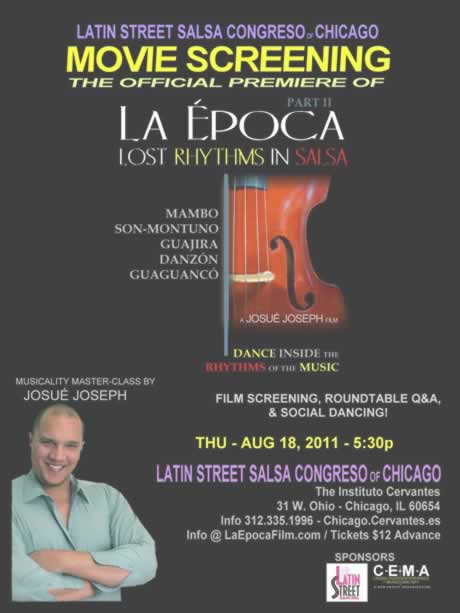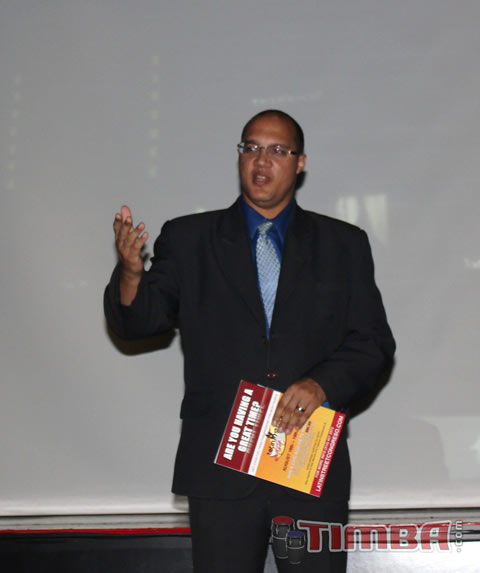Indice - Table of contents
Lo Nuevo[hide]
Grupos: Ritmo Oriental : 1988 - Vol. IX - 30 a...
Musicos: Rafael Paseiro Monzón
Musicos: Dennis Nicles Cobas
Musicos: Jiovanni Cofiño Sánchez
Musicos: Yasser Morejón Pino
Fotos: Tom Ehrlich : 2024 Monterey Jazz, P...
Resenas: Vacilón Santiaguero (Circle 9 ...
Staff: Bill Tilford
Fotos: Tom Ehrlich : 2024 Monterey Jazz, P...
Fotos: Tom Ehrlich : 2024 Monterey Jazz Fe...
Fotos: Tom Ehrlich : testing 123
Grupos: Pupy y los que S... : Discography - 1995- F...
Reportes: From The St... : Cubadisco 2...
Reportes: From The St... : Jazz Plaza ...
Fotos Del Día [hide]
Interviews & Reviews - La Epoca 2
Film Review -- La Época Part II: Lost Rhythms in Salsa
(Review by Bill Tilford, all rights reserved)
 A few months ago, we reviewed La Época Part I: The Palladium Era , a documentary by independent filmmaker Josué Joseph about the bands and dancers of the Mambo era associated with the Palladium Ballroom in New York City before the term "Salsa" had been coined. That film mentioned that many dancers and even many musicians had lost track of the distinctions between multiple rhythms that had been in use prior to the application of that label to almost all forms of Cuban and Puerto Rican dance music in the United States. Both that film and this new Part II were dedicated to the Afrocuban side of the story as it unfolded in the US. Since Part I did not cover the distinctions between these various rhythms in detail, we left our viewing of it eagerly waiting to see how the subject would be handled in Part II.
A few months ago, we reviewed La Época Part I: The Palladium Era , a documentary by independent filmmaker Josué Joseph about the bands and dancers of the Mambo era associated with the Palladium Ballroom in New York City before the term "Salsa" had been coined. That film mentioned that many dancers and even many musicians had lost track of the distinctions between multiple rhythms that had been in use prior to the application of that label to almost all forms of Cuban and Puerto Rican dance music in the United States. Both that film and this new Part II were dedicated to the Afrocuban side of the story as it unfolded in the US. Since Part I did not cover the distinctions between these various rhythms in detail, we left our viewing of it eagerly waiting to see how the subject would be handled in Part II.
We saw Part II at its Chicago premiere at the Instituto Cervantes on August 18 2011. This film has some assets and some liabilities. We'll start with the liabilities:
- The film runs well over two hours, which is a long run time for any documentary unless the material is edited tightly enough to consistently sustain interest throughout. We noticed that some of the footage used in Part II was also present in Part I. It's possible that the filmmaker did this in order to assure that viewers who missed Part I would still be exposed to a "common core" of material, but our opinion is that it would have been a better move to have more confidence in Part I of the series and dedicate the time in Part II to additional subject material or alternately reduce the run time by omitting some of the redundant footage, much of which was of dance instructors conversing (and possibly expendable in the second film).
- Perhaps as a consequence of the already-long run time, only some of the rhythms - Son Montuno, Guaguancó, Guajira, Bolero, Danzon, Mambo - were distinctly covered in detail. Some of the time dedicated to other items such as interviews with dance instructors could have been spent on some of the other rhythms and dance styles such as Son, Guaracha and Pachanga for example.
- The film's emphasis on the contributions of Arsenio Rodríguez to the music is a mixed blessing. On the one hand, it's true that Arsenio was an extremely important figure who frequently doesn't get his due. On the other, the tight focus on him could mislead some viewers without a background in the music into believing that nothing of significance came before him. One of the weaknesses of both Part I and Part II is that it doesn't really adequately address the Son as it developed in Cuba, and this was a necessary precursor to everything that came later. To truly place the history of the music in its proper context, it is appropriate to go back at least as far as Ignacio Piñeiro.

Josué Joseph (photo by Bill Tilford)
There are, however, some strengths as well:
- The rhythms (not the actual dance steps, but the rhythms) that are covered in the film are covered well enough for dancers to be able to identify the differences between them after watching the film. Although we wish that more had been portrayed in the film, on the whole, it did a good job with the material that it did choose to tackle.
- The live music sequences are well done, and if they accomplished nothing else, they captured some of the bass technique of Alfonso (El Panameño) Joseph, a bassist who is less well-known today than he should be.
- We said earlier that the focus on Arsenio Rodríguez was a mixed blessing, but the "blessing" part is that the film does bring him to the attention of a number of audience members that were probably completely unfamiliar with him or his contributions.
- Although the run time is long for a documentary of this sort, there are moments of humor in the film, and much of the "good stuff" is loaded towards the end of the movie.
- The archival dance footage should give today's dancers a great deal of food for thought about how they approach their styles now. It is also fun for even non-dancers to watch how it was done once upon a time.
The verdict? Viewers need to keep in perspective that this film and its predecessor cover some of the story as it evolved in the United States; things played out differently in Cuba, and a novice to the history of the music shouldn't leave the film believing that he or she now understands everything. That being said, we are of the opinion that dancers would probably benefit from watching the movie since it does cover some ground with which many of them are unfamiliar. Musicians would enjoy some of the archival dance footage as well as some of the live music sequences (which aren't profound but are enjoyable), and those who are struggling (or have struggled) against the excessive commercialization and simplification of the music will find some emotional validation in the film. In spite of its imperfections, on the whole the film was a worthwhile exercise in part because it helps rekindle the conversation about much of the music being "dumbed down" and might inspire some future auteur(s) to go deeper with documenting the history. (Some of the imperfections mentioned earlier could even be addressed by doing a "Director's Cut" of the film at some point).
The filmmaker's website (at which you can find DVDs and CDs of both films) is Laepocafilm.com
For a concise but scholarly treatment of Arsenio's contributions to the music in its proper perspective, we recommend visiting Kevin Moore's The Roots of Timba





















